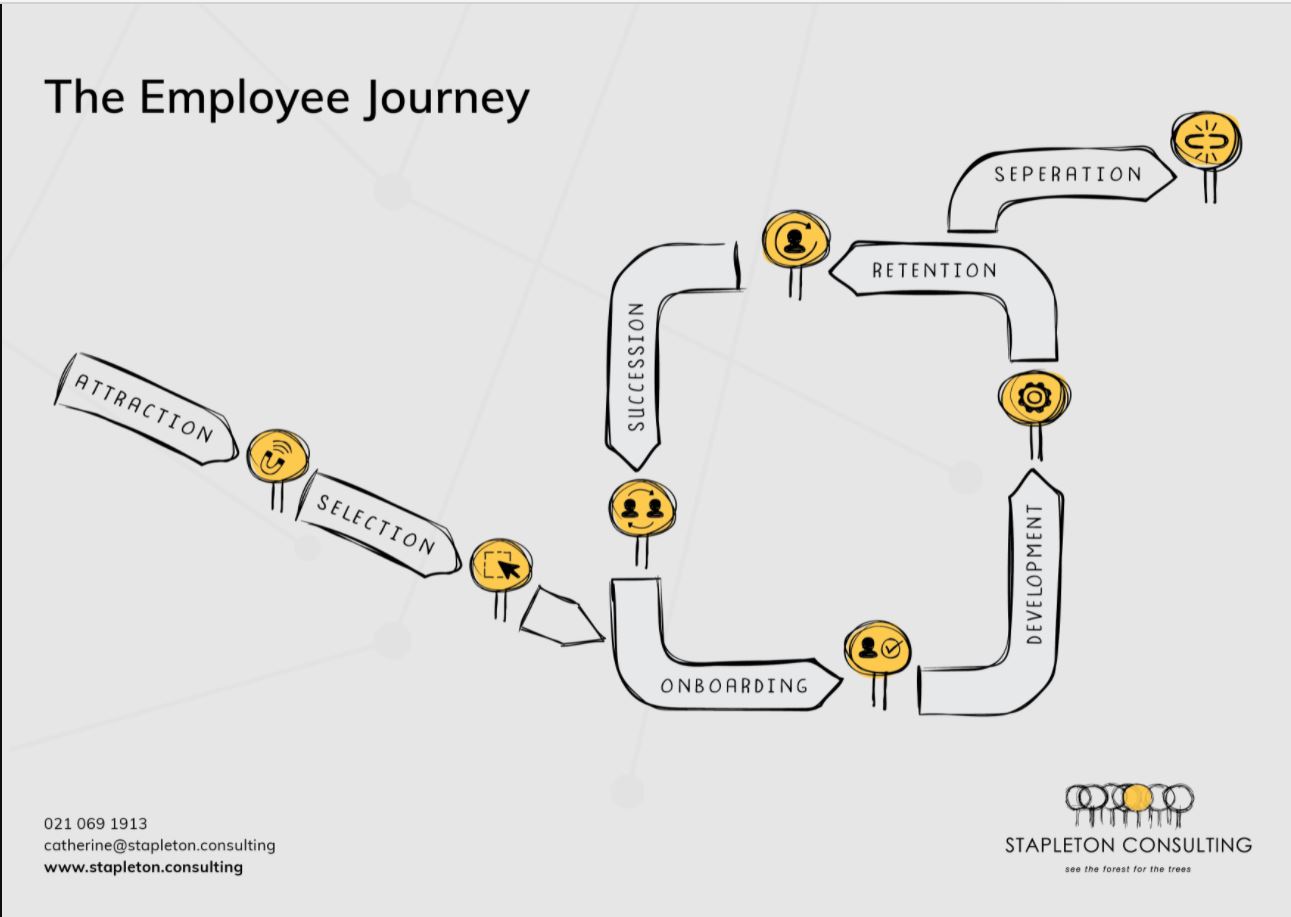
Being an employer can often feel overwhelming and difficult. As Jim Collins says on the journey of good to great it is about having the right people in the right place. If you hire well and bring your employees along the journey with you with purpose and clarity, that overwhelm (and turnover) can disappear.
In times like these where our borders are largely closed off from the outside world, it is hard to attract and find great people who have what you are seeking. It is equally hard to retain them. With a well-communicated and executed employment plan and good or even great leadership it is easy.
At Stapleton Consulting we use our employment journey framework to develop an HR plan and strategy for employers of all shapes and sizes. You can use this to design the kind of journey you want your employees to take with you. Again, I will reiterate, it is a journey you are both on together. Neither of you want to be flying solo in this relationship.
What does the Employment Journey look like?
It has key milestones and stages that are for the most part predictable. These are:
- Attraction
- Selection/Recruitment
- Induction/Onboarding
- Development
- Performance and Retention
- Succession
- Separation
You could put a rough timeframe around some of these stages, but for others, it can be fluid depending on the person, what’s happening in the business and the team. For instance, onboarding and induction can usually be around 7 weeks to 3 months, depending on the complexity of your business and the work required. Separation on the other hand can be as short as 1 week or as long as 3 months as it often, but not always relates to the notice period.
The underlying constants throughout the employment journey are your values, culture and behaviours, so when reading through this consider how would you do this in your business?
It is all too easy to copy the Googles and Perpetual Guardians of the world. Instead – You do you. Do what best reflects what you and your team are about.

Let’s break down these milestones some more and I’ll share some tips:
-
Attraction
This is all about how your business appeals to potential candidates. If you have recruitment on the cards soon, your business marketing strategy must cover off how you plan to get in front of potential candidates, and what is the value proposition. Why should they want to work with you? Where are these potential candidates hiding? What is the profile of your ideal employee? What are your funnels for recruitment?
If you thought this all sounds a bit like your sales pipeline, then you are right. Take a sales and marketing approach to your recruitment attraction strategy. The average recruitment process these days is taking about 8-12 weeks. Compared to pre-lockdown it was 6-8 weeks. Talented people at all levels across all industries are in hot demand.
-
Selection and recruitment
I liken recruitment to ‘dating’. You have found a potential employee, your candidate, and now it is time for each of you to figure out whether you are right for each other.
We take a values and competency-based approach to recruitment. Therefore, some recruitment processes will often have more than one interview or include online skills testing.
I am still surprised by the number of businesses that don’t bother to identify what skills and values they are looking for before they advertise. It is like going to the supermarket without your shopping list.
Also don’t rely on the interview alone. Even if they are your friends. Background checks such as reference checks and criminal record checks are a must have. Too many of the employment issues we deal with can be traced back to a poor recruitment process.
-
Onboarding
Now the person is signed up and committed to working with you, the real work begins. The last thing you would want them to think in their first week is – ‘what have I walked into? This is not what I signed up for!’
Have a plan, a checklist and communicate. Keep it simple and easy to follow. Most importantly the person who they report to, must be present. Even if you are a sole trader trying to do the work as well as run the business, you must make the time and prioritise their needs. Your clients will thank you for it.
Don’t know where to begin, then seek out help. An HR Consultant can help you with this too by the way. We don’t just deal with the problems.
-
Development
Your team member is getting comfy and understands most of their job and the business. They are still settling in and learning that nitty gritty stuff that takes time and practice more than anything.
This is your development phase. Just because you have made it through those initial months, it doesn’t mean you stop investing in developing your people. The development required to deepen their knowledge is often the forgotten step. It is what happens here that makes or breaks the employment relationship. If you have people leaving between 9-18 months of their employment, there is something you are missing.
Retention
The transition from development to retention can happen without you realising it. It is a subtle shift from them needing information and knowledge to do the work, to sharing what they know and improving what is already there. Based on experience this shift happens around 18 months.
There is no clear ‘what to do’ through the retention phase. What you do through this phase is all dependent on the person, what they are striving for, and what is happening in your business now and in the future. Personal development plans and coaching type conversations about work and their life in general will unlock what it is that will keep them. It won’t be money either by the way.
Ultimately you are working with the employee to look further ahead than just a couple of months. The conversation shifts to, a year or more ahead. This is in preparation for succession.
Succession
If you get to a point where you can progress a team member into a broader job scope or a new role in your business, then you are winning. You have a great employment relationship and you are mostly likely getting a return on the investments you made earlier on.
So many employment relationships don’t get this far. With the average length of service across NZ being somewhere between 18 months to 3 years, many are experiencing separation somewhere through that retention or development phase.
The key to a successful transition is not to load your star employee up with more, but to enable them to delegate some of their work and share their knowledge with others, as well as putting them on your most important opportunities.
After all, that valuable IP in their head shouldn’t just walked out the door when they leave. You and your team member, have a responsibility to extract this and share it so your return on investment from all that training during the earlier phases becomes realised.
Separation
Whether we like it or not, at some point your employment relationship will end in a separation. Sometimes it is to the benefit of both parties, but mostly it is to the detriment of you, the employer. So how do you facilitate this?
- Have a plan or checklist of what needs to be done and good communication all the way through – similar to the induction phase.
- Work respectfully and transparently with the employee so it doesn’t turn sour in those last few weeks.
- Recognise the value they have created and facilitate those goodbyes to happen where possible
- Exit interviews are brilliant for extracting the last bit of advice or intel, as well as providing a constructive way for the employee to vent any frustrations they may have bottled up.
- Keep an objective impartial person you trust close so you can share what is going on and get good advice. Separation can be an emotional rollercoaster for both parties.
As you can see the employment journey, is a journey. It won’t be perfect or smooth. There will be bumps in the road. Bring in the experts before you feel overwhelmed, and that vision ahead is getting clouded and you can’t see your way through that forest
Above all, while you work through the journey, do it together with regular open communication and in good faith. Sometimes you will lose good people along the way but keep that relationship on the right track and you will have a loyal advocate in the marketplace promoting your business, or a returning employee.
You can read about how Catherine and her team help their clients through the employment journey at her website, stapleton.consulting


